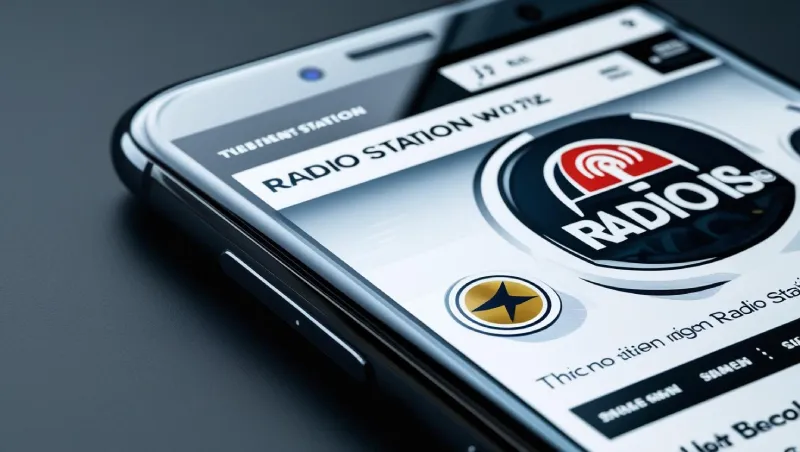The radio industry has always been about reaching people wherever they are—in their cars, at work, or at home. Today, “wherever they are” increasingly means on their smartphones. If your radio station’s digital presence isn’t optimized for mobile devices, you’re not just missing opportunities—you’re actively driving listeners away.
The Mobile Revolution Has Already Happened
The statistics paint a clear picture: mobile devices now account for over 60% of all web traffic, and this number continues to climb. For radio stations, the mobile shift is even more pronounced. Listeners expect to stream your content, check your playlist, engage with contests, and connect with your brand—all from their phones.
Consider this: when was the last time you saw someone pull out a laptop to quickly check a radio station’s website during their commute? The mobile-first approach isn’t about preparing for the future—it’s about meeting your audience where they already are.
What Mobile-First Design Really Means
Mobile-first design isn’t simply making your existing website work on smaller screens. It’s a fundamental shift in how you approach your digital strategy. Instead of designing for desktop computers and then squeezing everything onto mobile devices, you start with the mobile experience and build upward.
This approach forces you to prioritize what truly matters to your listeners. When you have limited screen real estate, every element must earn its place. The result is a cleaner, more focused user experience that works better across all devices—not just mobile ones.
The Cost of Getting It Wrong
Radio stations that ignore mobile-first design pay a steep price. Poor mobile experiences lead to frustrated users who bounce quickly from your site. This hurts your search engine rankings, reduces listener engagement, and ultimately impacts your ability to attract advertisers and sponsors.
Even worse, a clunky mobile experience can damage your brand’s credibility. If listeners struggle to navigate your website or streaming platform on their phones, they may question the quality of your overall operation. In an industry where trust and reliability are paramount, this perception can be devastating.
Essential Elements of Mobile-First Radio Design
Streamlined Navigation
Your mobile site’s navigation should be intuitive and thumb-friendly. Listeners should be able to access live streaming, program schedules, and contact information within one or two taps. Consider implementing a sticky navigation bar that remains accessible as users scroll.
Fast-Loading Streaming
Nothing kills the mobile experience faster than slow-loading streams. Optimize your streaming technology for mobile networks, and always provide clear feedback about connection status. Include data usage information to help listeners make informed decisions about their mobile data consumption.
Touch-Optimized Interactive Elements
Buttons, links, and form fields must be sized appropriately for touch interaction. The recommended minimum size is 44 pixels, but consider going larger for critical actions like “Listen Live” or “Request a Song.” Ensure adequate spacing between interactive elements to prevent accidental taps.
Content Prioritization
On mobile, your homepage should immediately present the most important information: current show, live streaming option, and recently played tracks. Secondary content like detailed program descriptions or staff bios can be accessible but shouldn’t dominate the initial view.
Social Media Integration
Make it effortless for mobile users to share content and follow your social media accounts. Implement native sharing capabilities and ensure social media feeds display properly on small screens.
Technical Considerations for Radio Stations
Progressive Web Apps (PWAs)
Consider developing a Progressive Web App that provides an app-like experience without requiring users to download anything from an app store. PWAs can work offline, send push notifications, and provide faster load times—perfect for radio stations.
Audio Player Optimization
Your mobile audio player should be robust yet simple. Include essential controls like play/pause, volume, and perhaps a 30-second replay button. Ensure the player remains functional even when users navigate to other parts of your site.
Performance Optimization
Mobile users often deal with slower internet connections. Optimize images, minify code, and leverage content delivery networks to ensure your site loads quickly regardless of connection speed.
Measuring Success on Mobile
Track mobile-specific metrics to understand how well your mobile-first approach is working. Key indicators include mobile bounce rate, time spent on mobile pages, mobile streaming session duration, and mobile conversion rates for contests or promotions.
Use tools like Google Analytics to segment your mobile traffic and identify areas for improvement. Pay particular attention to the mobile user journey—where do users enter your site, how do they navigate, and at what point do they leave?
Looking Forward: The Voice and Smart Device Integration
As you implement mobile-first design, consider how voice search and smart speakers fit into your strategy. Optimize your content for voice queries, and ensure your streaming services integrate well with smart home devices. The radio industry’s future lies in being accessible across all platforms and devices.
Making the Transition
If your radio station hasn’t embraced mobile-first design, start now. Begin by auditing your current mobile experience—visit your site on various mobile devices and honestly assess the user experience. Identify pain points and prioritize fixes based on their impact on core functions like streaming and content discovery.
Consider working with web developers who understand both the radio industry and mobile-first principles. The investment in proper mobile optimization will pay dividends in increased listener engagement, improved SEO performance, and enhanced brand perception.
Wrap-Up
Mobile-first design isn’t just a web development trend—it’s a fundamental shift in how your audience consumes content. Radio stations that embrace this reality will thrive in the digital landscape, while those that resist will find themselves increasingly irrelevant.
Your listeners are mobile, your competitors are going mobile, and your future success depends on meeting your audience where they are. The question isn’t whether you can afford to implement mobile-first design—it’s whether you can afford not to.
The radio waves may be invisible, but your digital presence shouldn’t be. Make sure it’s optimized for the devices your listeners actually use, and watch your engagement—and your station’s future—transform accordingly.
If you need assistance with your radio station website, we’re here to help. Contact us today!

